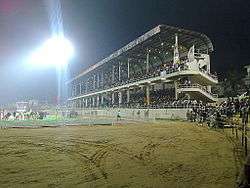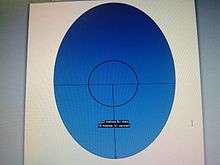Punjabi kabaddi
 Kabaddi at the Guru Gobind Singh Stadium | |
| Nicknames | Kauddi |
|---|---|
| Characteristics | |
| Contact | Yes |
| Team members | Teams of 8 |
| Venue | Circular pitch |
| Presence | |
| Country or region | Punjab region in Pakistan and India |
.jpg)

Punjabi kabaddi, also called kauddi, is a contact sport that originated in the Punjab region. There are a number of traditional Punjabi kabaddi styles traditionally played in the Punjab region. Circle style, also called Punjab Circle Style is played at state and international level[1] and is governed by the Amateur Circle Kabaddi Federation of India.[2]
Name
The term kabaddi may be derived from the Punjabi word "kauddi" (Punjabi: ਕੌਡੀ) which is chanted to play kabaddi or, it is derived from "katta" (calf) (Punjabi: ਕੱਟਾ) and "vaddi" (to chop) (Punjabi: ਵੱਢੀ) which together has become kabaddi.[1]
Traditional Punjabi kabaddi styles
Lambi kauddi
In lambi kauddi (Punjabi: ਲੰਬੀ ਕੌਡੀ) [3] there are 15 players with a circular pitch of 15–20 feet. There is no outer limit. The players can run as far they can. There is no referee. The raider will say "kauddi, kauddi" throughout the attack.
Saunchi kauddi
Saunchi kauddi (Punjabi: ਸੌਂਚੀ ਕੌਡੀ) [3] (also called Saunchi pakki/Punjabi: ਸੌਂਚੀ ਪੱਕੀ) can best be described as being similar to boxing. It is popular in the Malwa area of Punjab. It is unlimited players with a circular playing pitch. A bamboo with a red cloth is dug into the ground which is paraded by the winner.
In sauchi kabaddi, the raider will hit the defender but only on the chest. The defender will then hold the raiders wrist. A foul is declared if any other part of the body is grabbed. If the defender hold the raiders wrist and restricts his movement, he will be declared the winner. If the raider loses the grip of the defender, then the raider will be the winner.[3]
Goongi kabaddi
A popular style is Goongi kabaddi (Punjabi: ਗੂੰਗੀ ਕਬੱਡੀ) (silent kabaddi) where a raider player does not speak and say the word kabaddi but just touches the opponent’s team player and the whom he touches only that player will try to stop the player. The struggle will continue till he reaches the starting line or acknowledge the defeat and loses a point, or if he safely reaches the starting line, he will get the point.[4]
Other traditional styles
- Chhe handhi (Punjabi: ਛੈ ਹੰਧੀ);
- Shamiali wali (Punjabi: ਸ਼ਮਿਆਲੀ ਵਾਲੀ);
- Peer kauddi (Punjabi: ਪੀਰ ਕੌਡੀ);
- Parh kauddi (Punjabi: ਪੜ ਕੋੋੋਡੀ);
- Badhi (Punjabi: ਬਧੀ);
- Baithvi (Punjabi: ਬੈਠਵੀ),;
- Burjia wali (Punjabi: ਬੁਰਜੀਆ ਵਾਲੀ);
- Ghorh kabaddi (Punjabi: ਘੋੜ ਕਬੱਡੀ);
- Daudhey (Punjabi: ਦੋਧੇ);
- Cheervi (Punjabi: ਚੀਰਵੀ);
- Chatta wali (Punjabi: ਚਾਟਾ ਵਾਲੀ);
- Dhair kabaddi (Punjabi: ਢੇਰ ਕਬੱਡੀ) popular in Majha area of Punjab;
- Ambarsari (Punjabi: ਅੰਬਰਸਰੀ);
- Ferozpuri (Punjabi: ਫ਼ਿਰੋਜ਼ਪੁਰੀ);
- Lahori (Punjabi: ਲਾਹੌਰੀ);
- Multani (Punjabi: ਮੁਲਤਾਨੀ);
- Lyallpuri (Punjabi: ਲਾੲਿਰਪੁਰੀ);
- Bahwalpuri (Punjabi: ਬਹਾਵਲਪੁਰੀ); and
- Ambalvi (Punjabi: ਅੰਬਾਲਵੀ).[1]
Punjab Circle style
History and development
Kabaddi is the regional sport of the Punjab region and was referred to as Punjabi kabaddi in India and Pakistan. However, with the formation of the states of Haryana and Punjab in India, the same game was referred to as Punjab kabaddi and Haryana kabaddi. This caused confusion and therefore, in 1978, the Amateur Circle Kabaddi Federation of India was formed and the syle of kabaddi played in the Punjab region was named circle kabaddi.[4]
Punjab circle kabaddi, also known as "diarey wali kabaddi" (Punjabi: ਦਾੲਿਰੇ ਵਾਲੀ ਕਬੱਡੀ)[1] incorporates the kabaddi styles of the Punjab region.
Rules
In the Punjab region, kabaddi is played on a circular[1] pitch of a diameter of 22 meters and an inner circle with a line through the middle of the pitch: the pitch is called "kaudi da bharha". There are two teams of 8 players; one on one raid; and no player leaves the field.[3] If 2 stoppers attack a player, a foul is declared. Punjab style kabaddi does not require the raider saying "kabaddi, kabaddi" throughout the raid.[1] The game lasts for 40 minutes with a change in sides after 20 minutes.[3]
In the Punjab Circle Style form of Kabaddi, whenever any player is touched (out), he does not go out of the court, but stays inside, and one point is awarded to the team that touched him. This game is also played on a time basis, i.e. the time is 30 sec.
Notable competitions
Kabaddi World Cup
The circle style Kabaddi World Cup, is an international kabaddi competition administrated by the government of Punjab (India) contested by men’s and women’s national teams. The competition has been contested every year since the inaugural tournament in 2010, except for 2015 due to the 2015 Guru Granth Sahib desecration controversy. The women’s tournament was introduced in 2012. As of October 2016, every tournament, men’s and women’s, has been won by India.
Women’s Kabaddi World Cup
The first Women’s Kabaddi World Cup was held in Patna, India in 2012. India won the championship, defeating Iran in the finals.[5] India retained the title in 2013, defeating debutants New Zealand in the finals.
Asian Kabaddi Cup
The Asia Kabaddi Cup has been held twice in consecutive years. The inaugural tournament was held in 2011 in Iran. In 2012, the Asia Kabaddi Cup was held in Lahore (Pakistan) from 1 to 5 November. In the 2012 ASIA Kabaddi Cup, Pakistan won against India with a technical win after Indian team forfeited the match following a dispute.
UK Kabaddi Cup
Kabaddi received major recognition in the United Kingdom during the 2013 UK Kabaddi Cup. It featured the national kabaddi teams from India, England, Pakistan, the United States, Canada, and a local club team sponsored by SGPC. The UK Kabaddi Cup hosts the Punjab circle style of kabaddi.
World Kabaddi League
World Kabaddi League was formed in 2014.[6] The league includes eight teams from four countries – Canada, England, Pakistan, and the United States – and plays the Punjabi circle style of kabaddi.[7][7] Some of the teams are owned or part owned by actors – Akshay Kumar (Khalsa Warriors), Rajat Bedi (Punjab Thunder), Sonakshi Sinha (United Singhs) and Yo Yo Honey Singh (Yo Yo Tigers). The inaugural league season was played from August 2014 to December 2014.[8] United Singhs (Birmingham, England) won the finals defeating Khalsa Warriors (London, England) in the first season.[9][10]
Local tournaments
There are over 1,000 kabaddi tournaments held in Punjab,[1] some of which include the following
- Rurka Kalan Kabaddi tournament[11]
- Udham Singh Kabaddi Cup vill-Fattu Dhinga Dist-Kapurthala
- Baba Hastana Singh Kabaddi tournament vill-Khiranwali Dist-Kapurthala
- Hakimpur Kabaddi Games.[1] (Hakimpur is a village in Nawanshahr District)
- Mothada Kalan Kabaddi tournament.[12]
- Sant Maharaj Ishar Singh Ji Rara Sahib Kabaddi tournament
- Sant baba ram saroop kabaddi cup pind pipli teh and distt faridkot punjab
- Gholia kalan kabaddi cup,Moga
- Badowal kabaddi cup,ludhiana
See also
References
- 1 2 3 4 5 6 7 8 Kissa Kabaddi da by Sarwan Singh Sangam Publications ISBN 93-83654-65-1
- ↑ "Archived copy". Archived from the original on 2014-12-17. Retrieved 2014-12-07.
- 1 2 3 4 5 Punjab Diyan Virasiti Kheda by Suhdev Maudhupuri. Chetna Parkashan ISBN 817883213-5
- 1 2 "Amateur Circle Kabaddi Federation of India". Kabaddicircle.com. Retrieved 15 January 2018.
- ↑ "India win first women's Kabaddi World Cup". Hindustan Times. 4 March 2012. Archived from the original on 30 March 2012. Retrieved 4 April 2012.
- ↑ "World Kabaddi League launched". The Hindu. 25 July 2014. Retrieved 19 February 2017.
- 1 2 "World Kabaddi League announces team franchise names and logos". IBNLive. 24 July 2014. Retrieved 17 March 2013.
- ↑ "Home - The official website of World Kabaddi League". Worldkabaddileague.net. 9 August 2014. Retrieved 16 August 2014.
- ↑ "United Singhs crowned World Kabaddi League champions". IBNLive. 22 November 2014. Retrieved 17 March 2013.
- ↑ "Honey Singh's kabaddi team Yo Yo Tigers suspended". Hindustan Times. 15 November 2014. Archived from the original on 16 November 2014. Retrieved 17 March 2013.
- ↑ "Archived copy". Archived from the original on 2014-12-13. Retrieved 2014-12-08.
- ↑ "Hindustan Times". Hindustantimes.com. Archived from the original on 16 December 2014. Retrieved 15 January 2018.
